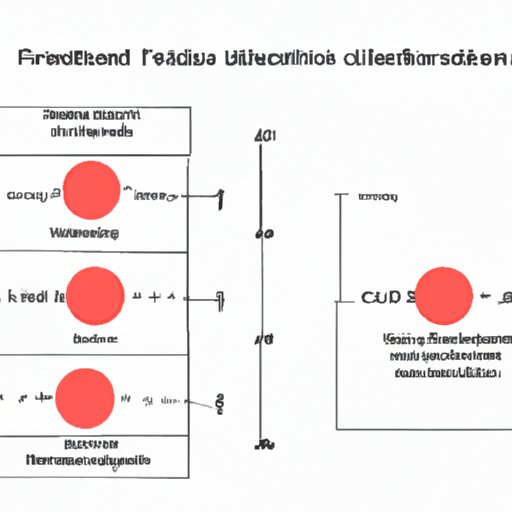Introduction
Statistics is an essential component to make sense of large amounts of data. One important concept in statistical analysis is the ‘F.’ In this article, we will explore what ‘F’ is, its significance in statistics, and its role in ANOVA and hypothesis testing. Understanding ‘F’ is critical for accurate statistical analysis and interpretation of data.
Understanding the Role of ‘F’ in Statistics: A Beginner’s Guide
‘F’ refers to the F-distribution, a probability distribution that is important in statistics. It is used to calculate the variability between groups and within groups. This distribution is the ratio of two chi-squared distributions, and it gives the probability of obtaining a particular ratio.
The F-distribution is crucial in many statistical analyses, including ANOVA, which is useful when there are multiple groups to compare. ‘F’ is used in ANOVA to compare differences between the means of two or more groups. This technique is applied in various fields like social sciences, medicine, engineering, and more.
From a statistical perspective, ‘F’ provides a way to calculate the variance of a sample. Variance is a measure of how much the numbers in a sample vary. In statistical analysis, we want to account for as much of this variation as possible to make our results more reliable and precise. ‘F’ plays a vital role in this process as it allows us to determine whether a difference in means is significant.
How ‘F’ Relates to ANOVA: A Statistical Concept Worth Knowing
The Analysis of Variance (ANOVA) is a statistical technique that compares the means of different groups to determine if there is a significant difference. It does so by taking into account the variability between groups as well as within groups.
‘F’ is used to perform ANOVA calculations. ANOVA separates the total variance into two components: the variance between the groups and the variance within the groups. This is where ‘F’ comes in. ‘F’ is the ratio of the variance between groups to the variance within groups. The higher the ‘F’ value, the more significant the difference is between the means of two groups.
For example, imagine a study to determine if two different fertilizers would significantly increase citrus tree growth. The study involves two groups, one receives fertilizer A, and the other fertilizer B. At the end of the study, the height of each tree in both groups is measured. ‘F’ would be used to determine whether the difference in tree height between the groups is significant or not.
Common Misconceptions About ‘F’ in Statistics
There are some common misconceptions about ‘F,’ which can lead to misinterpretation or incorrect conclusions. It’s important to address these misconceptions so that we can use ‘F’ in statistical analysis effectively, and with accurate results.
For example, one misconception is the idea that a higher ‘F’ value always means a significant difference between groups. It’s not necessarily true. The actual level of significance depends on the sample size and the degrees of freedom. Another misconception is that ‘F’ is the same as ‘T.’ They are not the same; ‘T’ is used when comparing two groups, while ‘F’ is used for more than two groups.
The Importance of ‘F’ in Hypothesis Testing
Hypothesis testing is a vital aspect of statistical analysis. It involves testing a hypothesis, or educated guess, to determine if it is correct or not. ‘F’ is important in hypothesis testing as it helps understand the variability, or in other words, the spread of the data.
When using ‘F’ in hypothesis testing, we calculate the ‘F’ statistic, which is used to determine if the differences seen in the data are significant. If the calculated ‘F’ value is higher than the critical value, then the result is considered statistically significant. ‘F’ is an essential component of this process because it determines the likelihood of any differences or effects in the data being present by chance alone.
Exploring the Relationship Between ‘F’ and ‘T’ in Statistics
‘T’ and ‘F’ are both statistical tests used in hypothesis testing, but there are some differences between them. ‘T’ is used to compare the means of two groups, while ‘F’ is used for more than two groups. For example, if we only had two groups in our citrus tree growth study, we would use ‘T’ to determine if there is a significant difference between them.
The decision to use ‘T’ or ‘F’ is based on the number of groups being compared. Single-sample and two-sample t-tests can be used to compare the means of two groups. However, if there are more than two groups, we use ANOVA, which is calculated using ‘F.’
Real-World Applications for ‘F’ in Statistics
There are many real-world applications of ‘F’ in statistics. One common use of ‘F’ is in the analysis of clinical trials, where multiple treatments are being compared. Another example is in quality control where the data is being compared across multiple manufacturing plants or production lines.
‘F’ is also used in financial analysis to compare the performance of different investment portfolios or in sports statistics to compare the performance of different players or teams.
Conclusion
In conclusion, ‘F’ is a critical component of statistical analysis. It is a probability distribution used to determine the difference between groups, and its significance in ANOVA and hypothesis testing cannot be overstated. Understanding how ‘F’ works and its role in statistical methods is crucial to conducting accurate analyses. Misconceptions about ‘F’ can lead to incorrect conclusions in statistical analysis, so it’s important to have an accurate understanding. By becoming familiar with ‘F,’ researchers and analysts of all fields can accurately interpret data and make informed decisions.
